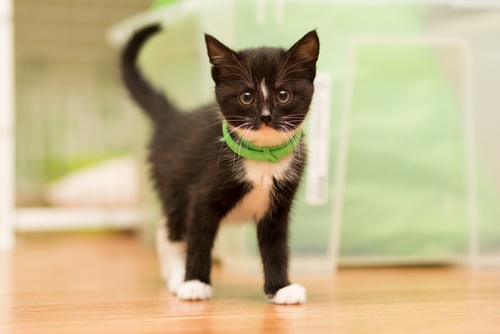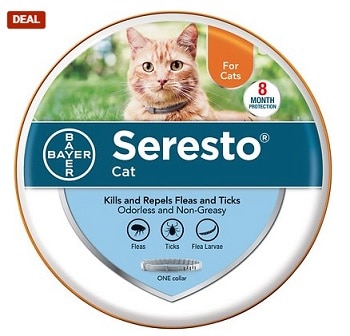
Invented in 1964 by entomologist Robert Goulding, Jr., the flea collar is one of the most readily available forms of flea treatment for cats. Usually made from plastic resin and infused with an insecticide or combination of insecticides, flea collars are inexpensive, simple to use, and relatively effective for repelling and killing adult fleas.
An article on MedicAnimal says that using flea collars for cats “…used to be the most popular and accessible flea control option, until the newer spot-ons that proved to be safer and more effective were developed.”
In a world of diverse and often easy-to-access flea treatments for cats, flea collars are no longer the best option for most guardians. In this article, we’ll explore the different types of flea collars on the market, learn whether or not they’re safe, and investigate what differentiates them from other flea treatments.
There’s only one flea collar that’s consistently recommended by veterinarians and appreciated by cat guardians at the same time. If you want to skip to our number one choice for the best flea collar for cats, scroll to the bottom of the page.
Quick Overview:
Our top pick is for the Best Flea Collar for Cats: Bayer Seresto Flea and Tick Collar for Cats.
This absorption-based flea collar stands out from the crowd with its use of flumethrin and imidacloprid, two insecticides with a reputation for safety. There is more information on the Bayer Seresto Flea and Tick Collar further down the article. In the meantime let’s breakdown the different types of flea collars available on the market today and how safe they really our for our cats.
Types of Flea Collars for Cats
Gas-Based Flea Collars for Cats
These collars release insecticides in a gaseous form.
Most veterinarians don’t like these flea collars and describe them as ineffective. They emit gases from your cat’s neck area and have a limited range, sometimes not spreading all the way across your cat’s body to their hindquarters, where fleas tend to concentrate.
Absorption-Based Flea Collars for Cats
These collars release small amounts of insecticides across your cat’s skin. The insecticides seep down into the hair follicles and sebaceous glands, turning your cat’s skin and coat into an insecticide minefield for any fleas that try to take a sip of their blood.
These are usually considered the most effective type of flea collar for cats. They kill adult fleas and protect your cat from newcomers for 7-9 months.
In most cases, flea collars are only effective for killing adult fleas. Some, however, contain insect growth regulators – also known as IGR’s – which prevent fleas from reaching maturity and reproducing.
Natural and Herbal Flea Collars for Cats
If you’re concerned about the toxicity of conventional collars made with chemical insecticides, you might opt for a so-called natural or herbal flea collar instead.
When asked about these alternative flea collars, Andrea M. Brodie, DVM says that, “They do not work. I suggest you do not use flea collars on your cat as there is always the danger of the cat getting hung up with the collar somewhere and getting hurt. The best would be to use a spot on for cats.”
Dr. Brodie’s recommendation is echoed by most other veterinarians and cat guardians. These collars have limited effectiveness and sometimes do more harm than good.
Ultrasonic Flea Collars for Cats
Back in the ‘60s, a space-age concept was born – a flea collar that, instead of using insecticides to deter and destroy fleas, emits a high-frequency noise – 20 to 60 kHz. Theoretically, this sound sends fleas packing.
It’s an interesting concept, especially considering the risks associated with strapping a strip of toxins around your cat’s neck, but it’s seriously flawed.
There’s no reason to think that ultrasonic flea collars work. In one study, even increasing the collar’s frequency output by 6,000 times did nothing to alter flea behavior. That doesn’t mean that anecdotal evidence hasn’t kept these noisemaking collars alive.
If you do choose to take a gamble on an ultrasonic collar, know that one of these will set you back around $40.
Do Flea Collars Work – And Are They Safe for Cats?

Flea collars for cats are often thought of as the easy way to treat a parasite infestation.
Because they’re often cheaper than other flea treatments, flea collars are easy to buy. They’re also easy to put on. Some cats don’t like the feeling of a spot-on applied to their back and many refuse to accept an oral pill. And it’s particularly rare to find a cat who accepts a flea bath.
Compared to these alternatives, flea collars are a simple choice with a high rate of what manufacturers call “owner compliance”.
But there’s another side to the flea collar story that’s much uglier – as ugly as raw, hairless skin around the neck. As ugly as children being exposed to dangerous concentrations of neurotoxins.
“The use of any product on the market to control fleas on pets is associated with a degree of hazard to the animal.” – Claude Kissin, Vice President, Hartz Mountain Corp., 1987
As Mr. Kissin reminds us, all chemical flea treatments are inherently dangerous. You can’t avoid some degree of risk, whether you’re flea bombing your house, shampooing your cat, applying a topical, or using a flea collar for cats.
Also Read: Best Flea Shampoo for Cats
Flea collars are one of the worst choices for treating your cat’s flea infestation. Here’s why.
Whether they’re infused with insecticides or not, collars are always a risky choice for cats.
Even if you adjust it correctly, choose a breakaway collar, and give your cat the right size, wearing a collar puts your cat at risk for choking or worse. The collar could catch on something while your cat is exploring.
Flea collars often contain insecticide chemicals that are more dangerous than those found in other flea treatment products.
More than any other flea treatment, flea collars have been implicated in reactions including seizures, rashes, and death. Flea collars are most often made with tetrachlorvinphos, proxopur, and permethrin, all of which pose serious health risks to both cats and humans.
Negative reactions are unconscionably common.
Many cats have allergic or chemical reactions to the plastic resins or insecticides that flea collars are made from, causing rashiness and blisters around the neck along with itchiness and soreness all over the body.
Flea collars cover your cat in insecticides that could make you and your family sick.
While these products are legally sold in many regions, they’re not universally accepted.
In 2012, the French Agence Nationale du Médicament Vétérinaire watchdog group withdrew the permit for the sale of certain flea collars containing organophosphates, a group of toxins that exist in some of the most popular over-the-counter flea collars for cats. Organophosphates banned from sale in France include Dimpylate (or Diazinon), Propoxur, and Tetrachlorvinphos.
Flea collars are a particularly dangerous choice if your cat shares the home with infants or toddlers, who are particularly susceptible to neurotoxin poisoning.
“During fetal development and the first years of life, infants are much less able to detoxify most pesticides and are uniquely vulnerable to developmental toxins, especially neurotoxins, given that the brain and nervous system continue developing through about age 12.” – Charles M. Benbrook, 2003
Besides being risky for your cat, flea collars could also make the household humans sick. A health organization called the NRDC has released a damning report on the effects of flea collars for human health.
After just three days, 100% of cats wearing proxopur-based collars had enough residue on their fur to pose a neurological risk to toddlers who had a lot of contact with their pets. The study also found an increased risk for cancer for both adults and children exposed to proxopur.
Remember that it’s critical to read the label carefully. Avoid flea collars and other flea treatments made for dogs, which often contain permethrin. This is a highly-concentrated synthetic insecticide that can make your cat seriously ill.
Note that your cat could also become sick from contact with a treated household pet, so it’s important to think of everyone in the home when choosing a flea treatment.
To avoid the most dangerous insecticides, we’ve eliminated the following flea collars:
Flea Collars Containing Proxopur:
- Bansect Flea and Tick Collar for Dogs and Cats
- Scratchex Color-Full Flea and Tick Collar for Cats
- Sergeant’s Double Duty Flea and Tick Collar for Cats
- Vet-Kem Breakaway Plus Flea and Tick Collar for Cats
Flea Collars Containing Tetrachlorvinphos:
- Zodiac Breakaway Flea and Tick Collar for Cats
- Adams Plus Cat & Kitten Flea & Tick Collar
- Hartz Ultraguard Plus for Cats and Kittens
- Bio Spot Active Care Breakaway Flea & Tick Collar for Cats & Kittens
Flea Collars Containing Permethrin:
- Beaphar Soft Cat Flea Collar
So, Should You Use Flea Collars for Cats?
In most cases, the answer is no.
Most veterinarians agree that flea collars are at once more dangerous and less effective, on average, than other flea treatments.
Click Here For A Useful Directory Of Some Of The Most Popular Flea Treatments On The Market
All this having been said, there is just one flea collar for cats that has a good reputation.
Whether you choose to use a flea collar or not, remember that the war on fleas has multiple fronts.
Remember that only about 5% of the infestation lies on your cat’s body – the rest of it is squirming in your carpet or pupating between your couch cushions. Considering the unique life cycle of the cat flea and its ability to remain dormant for up to a year, treating a flea infestation requires a combination of aggression and tenacity.
Devising a complete anti-flea strategy involves targeting fleas both on your cat and in their environment.
While slapping on a flea collar is advertised as a simpler way to stop fleas, the truth is that doing so leads to slow results, comes with a high risk of toxicity, and is sometimes completely useless. There are many other options on the market, and many are far more effective than a flea collar.
Click Here For Our Comprehensive Guide To The Best Cat Flea Treatment.

Saresto flea collars are linked to 2500 pet deaths.
https://www.cbsnews.com/amp/news/seresto-collar-deaths-symptoms-collar-should-be-recalled-fleas-ticks-report-says/
Thank you for sharing this.
IT is not TRUE DOMNT LISTEN tlon her MALORERYIE i am this many years old llllllllllllllllllllllllllllllllllllllllllllllllllllllll
Not sure what you mean by this, but thanks for the comment!